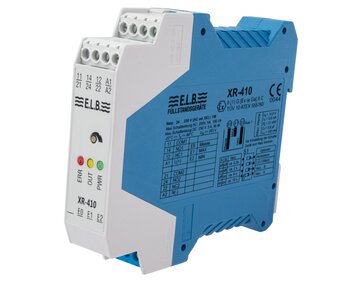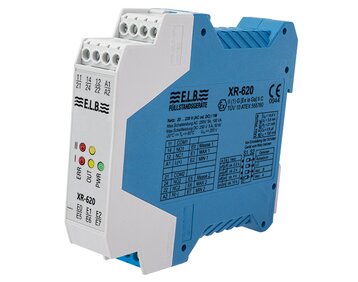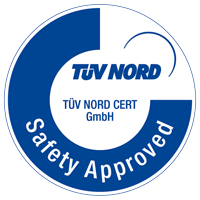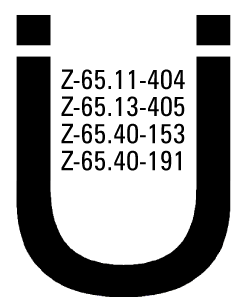Description
The electrode relays are used for conductive level detection. levels. The possible applications extend areas where conductive, liquid media are to be detected, controlled to be detected, controlled or regulated. Hereby level detection (overflow / dry run) as well as minimum / maximum as well as minimum / maximum controls can be realised. The contact protection relays are universal measuring transducers, which input signals (resistance values) with "Namur" specification (DIN EN 60947). Namur" specification (DIN EN 60947) into switching signals of floating output contacts.
Technical Data
Protection class EN60529
- clamp
- IP20
- Housing
- IP40
Technical Data
- Operating temperature
- -20...+60 °C
- Storage temperature
- -30...+80 °C
- Output contacts
- potentialfrei
- Switching voltage
- min. 5 V | max. 250 V AC / 150 V DC
- Switching current
- min. 5 mA | max. 5 A AC / 5 A DC
- Switching capacity
- min. 300 mW | max. 100 VA / 50 W
- Quiescent current
- umschaltbar
- Weight
- ca. 250 g
- CE marking
- siehe Konformitätserklärung
- Ex-protection/IECEx
- siehe Prüfbescheinigung
Further product information
Electrode relay
The electrode relay supplies a measuring voltage which is applied to the earth electrode and the other electrodes. When the earth electrode and another liquid are immersed, a low AC measuring current flows, which signals "medium present / not present"
This alternating current is detected and evaluated by the electrode relay. The response sensitivity of the electrode relays can be optimally adjusted for different media. Even boundary layer detection between media of different conductivities is possible. Electrolytic decomposition of the medium and dangerous contact voltages are reliably avoided.
In hazardous areas, the electrode relays serve as an interface (galvanic isolation) between the Ex and non-Ex areas. The intrinsically safe circuit is safely galvanically isolated from the non-intrinsically safe circuit up to a peak voltage value of 375 V. The electrode relays themselves (without additional protective measures) must not be operated in Ex areas. When installed in an Ex-approved enclosure, operation in the Ex-area is possible. The safe isolation has been tested and certified by TÜV.
Electrode relays can also be used as contact protection relays in applications where signal transmitters with a low permissible contact load (e.g. < 10 mA) are to switch larger loads.
- Working quiescent current switchable
- Safe galvanic isolation between input, mains and contacts
- Adjustable sensitivity ranges
- Various supply voltages
- Various switching delays (also adjustable)
- Acknowledgement button optional
- 1- and 2-channel relay, 2-channel relay detects 2 limit values or 2 MinMax or 1 MinMax and 1 limit value
- 19" card version
- TÜV ATEX approved (ER-142... and ER-143...)
- ER-214 is based on microprocessor technology
System structure
The conductive level detection consists of rod, suspended or adjustable electrodes and the electrode relays.
Contact protection relay
The contact protection relays operate according to the closed-circuit current principle, i.e. if there is no overflow or leakage signal, an operating current flows via the transmitter. As long as this is the case, the output relay remains energised. It only drops out when either the response level is reached, the line is interrupted or the supply voltage fails.
The contact protection relays are used in conjunction with our overfill prevention devices (T200F...) and leakage probes (T200L...), among others.
In potentially explosive areas, the contact protection relay serves as an interface between the Ex and non-Ex areas. The intrinsically safe circuit is galvanically separated from
the non-intrinsically safe circuit. The contact protection relays themselves (without additional protective measures) must not be operated in hazardous
areas. When installed in an Ex-approved enclosure, operation in the Ex-area is possible. The safe isolation has been tested and certified by TÜV.
- Design approved as part of an overfill protection system (Z-65.11-404) / leakage protection system (Z-65.40-153)
- Line monitoring (cable break / cable short circuit) in connection with our overfill / leakage probes
- Safe galvanic isolation between input, mains and contacts
- Various supply voltages
- 1 and 2 channel relay
- 19" card version
- TÜV ATEX approved (KR-163/A/Ex...)
System structure
The overfill protection or leakage detection system consists of the level sensor (T200F...) or the leakage probe (T200L...) and a contact protection relay.
Documents and Downloads
General information
Mounting and installation instructions
test certificate
declaration of conformity
products in this series
4 variants are displayed














